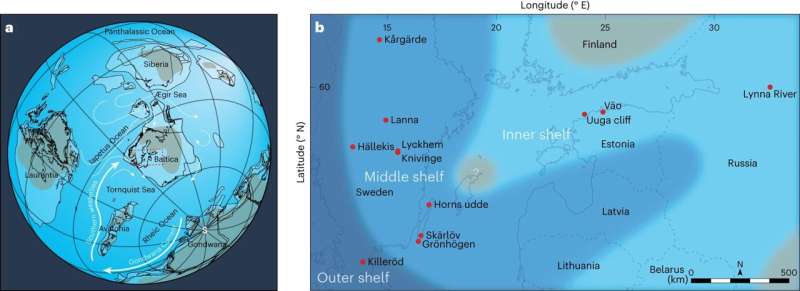This article has been reviewed according to Science X's editorial process and policies. Editors have highlighted the following attributes while ensuring the content's credibility:
fact-checked
peer-reviewed publication
trusted source
proofread
Scientists find oxygen levels increased during boom in ancient marine life

Florida State University scientists have uncovered answers to a conundrum in Earth's history: Why did marine life experience an extraordinary boom millions of years ago?
Scientists have long been puzzled about what triggered this explosion of life and a remarkable increase in the diversity of marine species during the Ordovician Period roughly 487 to 443 million years ago. A new study led by FSU Associate Professor of Geology Seth Young and postdoctoral fellow Anders Lindskog has provided insights into this ancient ecological transformation and the role oxygen played in it. Their study was published in Nature Geoscience.
To unravel the ancient mystery, Lindskog and Young embarked on a mission with colleagues at FSU and Lund University in Sweden to understand the environmental conditions, particularly the oxygen levels in the ancient seas, of the Ordovician Period. Oxygen is essential for the development of higher organisms, so it's a key player in the evolution of marine life.
"By better understanding the backdrop to these changes, we can better understand the mechanisms that drive large-scale and long-term evolution—basically, how life became what it is today," said Lindskog, who is now at Lund University.
The researchers used limestone samples from modern-day Scandinavia, including regions in Sweden, Estonia and western Russia, which were part of the paleocontinent Baltica.
They analyzed iodine and calcium levels within the rocks, which provided a window into the oxygen content of the ancient oceans. The higher the iodine-to-calcium ratio in the samples, the greater the oxygen levels at that location during that time.
This technique allowed them to track changes in oxygen conditions over the Ordovician Period.
"Our study employed a relatively new analytical approach, and our results show that it is a very useful tool for understanding and precisely mapping relative oxygen levels in the oceans of both past and present," Lindskog said.
The study's findings revealed a gradual increase in oxygen levels within the Ordovician oceans, particularly during the early to middle stages of this period. These well-oxygenated waters were traced back to the ancient Iapetus Ocean, near the equator.
The time periods with the highest oxygen concentrations, as indicated by peak iodine-to-calcium values, coincided with the most significant increases in biodiversity and shifts in ecosystems.
The researchers also highlighted the intricate relationship between climate, changing sea levels and oxygenation during the Ordovician Period.
Cooler climates held more dissolved oxygen in water and decreasing sea levels facilitated oxygen access by bringing shallower waters into contact with the atmosphere. Additionally, the mid-latitude location of Baltica promoted strong ocean currents and wind activity, further enhancing oxygenation.
While this study delves into Earth's ancient history, it provides insights into how life responds to environmental changes over a variety of time scales and carries significant implications for addressing contemporary environmental challenges, Young said.
By examining Earth's past, the researchers said, scientists can gain a better understanding of the potential consequences of ongoing climate change and make more informed predictions about the future health of marine ecosystems.
The findings underscore the critical role of oxygen availability in marine ecosystems and its sensitivity to changes in climate.
"Our results show fundamental connections between climate, environment and oxygen conditions in Earth's past oceans, and how these have influenced life through deep time," Lindskog said.
As global temperatures rise and oxygen levels in modern oceans are expected to decline, the study suggests that concerns about the long-term impact on marine life and habitats are well-founded, he said.
More information: Lindskog, A. et al. Oxygenation of the Baltoscandian shelf linked to Ordovician biodiversification, Nature Geoscience (2023). DOI: 10.1038/s41561-023-01287-z www.nature.com/articles/s41561-023-01287-z
Journal information: Nature Geoscience
Provided by Florida State University




















